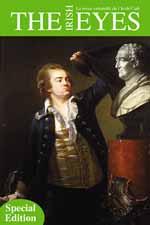
THE LAST IRISH JACOBITE
by Michael Scott
The case of General Sir John O'Sullivan Beare is exemplary of the most romantic, if not romanticised, part of the long history of the Irish Diaspora, the epic of the Irish military Jacobites, the Wild Geese. It is a story of courage in the face of adversity, and of attachment to values being swept away by the flood-tides of, then, contemporary history. He also exemplifies difficulties of Celto-Celtic understanding still extant. For O'Sullivan was both the best friend to the legitimate heir to the throne of England and Scotland and the object of the bitter rivalry of the principal military leader of the Scottish Jacobites, Lord George Murray.
Born in Cappanacusha Castle in Kerry in 1700, after schooling in Paris and Rome, he became a professional soldier and aide-de-camp to Maréchal de Maillebois with whom he served notably in the Corsican campaign of 1739, acquiring considerable knowledge of guerrilla warfare (Maillebois when inebri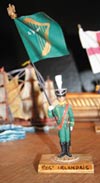 ated handed over command to O'Sullivan). ated handed over command to O'Sullivan).
He was one of the seven men of Moidart with Bonny Prince Charlie, was made a colonel on landing and Quartermaster-General after the Battle of Prestonpans. After Culloden, he was knight-ed by James III (Jacobite) and later awarded a hereditary baronetcy.
A contemporary describes O'Sullivan as, "one of the best bred, most genteel, agreeable and pleasing of the French troops…to these external accomplishments were added, and Juba (code name for Prince Charles Edward) soon perceived them,…a sincerity of heart and an honest freedom of both sentiment and speech, tempered with so much good nature and polite-ness as made his conversation and friendship equally useful and agreeable".
If Sir John was the kind of man who had difficulty hating others (he was above that), the opposite was true of Murray. After Culloden, Murray writes of the Irish adventures and flatterers whose advice was to ruin the Prince, and in particular condemns General O'Sullivan's choice of Culloden as a battlefield. It is true that on each major military decision, O'Sullivan and Murray had totally contrary views and advice, two versions of reality. Murray's version was speedily published and, corresponding unfortunately to certain innate prejudices among the Scots, became Bible truth. O'Sullivan's version, written for the Old Pretender in Rome, remained unknown until it was brought back to England to be preserved with the State papers in the archives of Windsor Castle, and unpublish-ed till 1938 in the splendid book by 1745 and After, by Alistair and Henrietta Tayler. The date of publication indicates why this righting of a historical wrong did not become a talking point and why sloppy historians continue to expostulate as if the Stuart Papers did not exist.
The meat of the matter is, of course, military. Who got it wrong?
In order to answer this crucial question we must ask who was for and who against turning back at Derby (the beginning of the long road to defeat, and hopelessness)? Who ordered the disastrous, and useless night march before Culloden to surprise the enemy camp at Nairn, leaving some of the Highlanders so tired they slept next day on the battlefield? Who refused the right wing of the line of battle to the MacDonalds as the battle was about to be engaged, creating confusion and disappointment and, lastly, who refused to se-cure the inner wall of the grounds of Culloden House, allowing the enemy to do so and rake the Highland Army with devastating flanking fire?
The student of history sensi-tive to facts will already be
murmuring, "certainly not O'Sulllivan". No, certainly not. The unfortunate Murray, an unwilling Jacobite at the best of times, although he had the satisfaction of outranking and outweighing O'Sullivan, must also have been saddened to have been considered by many of his Jacobite contemporaries as a traitor, so disastrous his influence and his call on military matters. He was to die and be buried in Holland where his headstone reads, rather appropriately, and certainly ironically, "Het Englischer" (the Englishman).
After Culloden, O'Sullivan alone remained with Prince Charles Edward, sharing the suffering and dangers imposed by the great Hanoverian manhunt. He eventually succeeded in escaping, jumping ship to Norway, seeking help and a ship to rescue Bonnie Prince Charlie and saving if not the cause, at least the person of he who, it had been hoped, would become the future legitimate king of England (it should be remembered that the Hanoverian monarchy was based on the principle of illegitimacy, i.e. the non-respect of blood ties, George lst being only 53rd in line to the throne. A descendant of O'Sullivan on the basis of the Mayor of the Palace precedent might well make as good a claim).
We have no portrait of O'Sullivan and can only sense his being through the impression he left on his contemporaries. We see a large, cordial, outgoing man, possessed of what in those days was a minor weakness, a fondness for drink, and in particular, Mountain Malaga. Perhaps he was the last of the unreconstructed Irish, those Irish Jacobites who preferred exile to submission to the Penal Laws and brought the best of the island into exile with them. He was very much a gentleman in the best etymological sense of the word, as well as in the more vulgar sense, as can be seen by the reaction to him of people as varied as Prince Charles Edward and Louis XV. He was perhaps the last of the great Irish military Jacobites.
The boyish good nature of the man hardly survived the memory of his contemporaries. Let this not also be said of his military competency.
www.jacobite.ca/
TOP
THE O'NEILL WILD GEESE
By Hugo O'Neill
When my kinsmen Hugh O'Neill and Rory O'Donnell left Ireland in September 1607 to seek European support to gather a liberation army, an episode that 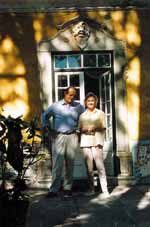 became known as The Flight of the Earls, they became, perhaps unknowingly, the leaders of an exodus of Irishman, evoked as the Wild Geese for the hope in their return. became known as The Flight of the Earls, they became, perhaps unknowingly, the leaders of an exodus of Irishman, evoked as the Wild Geese for the hope in their return.
Hugh O'Neill was not successful in his attempt to seek support from the leaders of Catholic Europe, as his cause was deemed politically incorrect. The Catholic kings of Spain and France did not wish to disturb the accession of the also Catholic James I to the throne of England, and so he spent his last years in Rome, where he died in 1616 trying to fight the indifference of kings and pope.
The incredibly oppressive and inhuman colonization of Ireland followed, prompted perhaps by the perception that the Irish were a far more civilised people,
although much less prone to submission than expected. The disasters of Boyne and Aughrim led the Irish elite to leave the country for France and keep up their fight against William III and Marlborough.
Many never returned. Brave as they were, some found easy employment as soldiers in the armies of their host countries, while others, who opted to remain independent, excelled in trade, in the wine business and also in shipping, helped by their ancestral self-reliance, cunning and addiction to challenge.
This is also the story of my forefathers. Phelim O'Neill, the grandfather of Shane who came to Portugal, fought as an officer of the O'Neill regiment in Ireland and then in France, Italy and Germany, where he distinguished himself as a gallant officer, and fell campaigning at Malplaquet in 1709.
Shane O'Neill, his grandson left Ireland in 1740 to seek a new life in Lisbon. He was helped in this by the Archbishop of Armagh who, together with the Bishop of Dromore, had his pedigree attested and got him the assistance of the Rector of the Irish College in Lisbon. He was well received at the court of King John V and by the Irish community in Lisbon, married the daughter of a Portuguese landowner and started his new life in Lisbon, in the wine business.
He was succeeded by his son Carlos, who was educated at St. Omer in France and married a German heiress whose fortune he enlarged. Sought as a man of good advice by the Marquis of Pombal, the then-strong Prime Minister of Portugal and later by Queen D. Maria I, he became Consul of the United States and of Denmark and was instrumental in developing important trade relationships between northern Europe, the United States and Portugal.
José Maria O'Neill, Carlos' son and heir, took sides with Peter IV, the liberal and rightful heir to the throne, in the bitter and bloody civil war won against the ancient regime's ultra-aristocracy, led by Miguel his younger brother. Successful investments and the development of international trade links with Scandinavia and the Baltic states prompted the family to thrive during the remainder of the XIX century.
We have been brought up to respect the Irish values of personal dignity, truth, fair-ness and merit. And we took seriously our heritage as heads of the senior branch of the O'Neill family.
My great-grandfather was encouraged by Sir Roger Casement to return to Ireland and take up his role as O'Neill, and was invited by Yeats to attend the 1925 festivities to celebrate the Home Rule, but he sadly passed away before that event. The return of the Wild Geese was symbolically feted by our branch of the family in 1982 when Jorge, my late Father, was inaugurated as O'Neill at Shane's Castle in Antrim, the ancient seat of the family now belonging to Lord O'Neill.
www.heritage-irlandais.com.
TOP
SOLDIERS AND CHIEFS
by Louise Cunningham
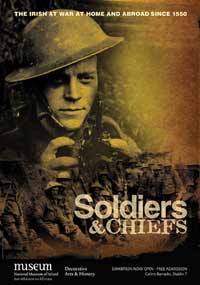 With the approaching anniversary of the Flight of the Earls the National Museum of Ireland recently launched its latest permanent exhibition. Soldiers and Chiefs: The Irish at War at Home and Abroad, 1550-2001 is a timely response to the growing interest in the story of the Wild Geese, those soldiers from Ireland who sought freedom or fortune in other lands. I went to check it out, in the appropriate setting of the Collins Barracks, a cavernous military building overlooking the Liffey, where one can practically hear the centuries of marching boots in the courtyard. With the approaching anniversary of the Flight of the Earls the National Museum of Ireland recently launched its latest permanent exhibition. Soldiers and Chiefs: The Irish at War at Home and Abroad, 1550-2001 is a timely response to the growing interest in the story of the Wild Geese, those soldiers from Ireland who sought freedom or fortune in other lands. I went to check it out, in the appropriate setting of the Collins Barracks, a cavernous military building overlooking the Liffey, where one can practically hear the centuries of marching boots in the courtyard.
The exhibition, ranging from the late 16th century to the conflicts of the present day, charts the long history of the Irish soldiers who fought in foreign armies all over the world, and also of the conflicts fought in Ireland over the last 450 years.
One section is devoted to the Wild Geese, referring both as a generic term to Irish soldiers in foreign armies - an exodus which began as far back as the late 16th century - and more specifically to those who fought for the Jacobite cause under Patrick Sarsfield and went into exile in France after their defeat by William III. It details the five Irish regiments formed there, who were permitted to wear not the standard green of the French army, but their own distinctive red uniform which identified them with the Stuart dynasty and King James II.
The Irish tradition of soldiering abroad continued down through the centuries for various reasons, money, adventure or family tradition, but the original Wild Geese went to fight for the enemies of England, in the eventual hope of overthrowing foreign rule in their homeland. Irish soldiers could even find themselves fighting one another on opposite sides, as occurred in February 1702 at the Battle of Cremona when Mayo man Frances McDonnell, serving in the Austrian army, captured French Marshall Villeroi and was subsequently (unsuccessfully) despatched to persuade or bribe several thousand troops of the Irish Brigade to change sides and fight for Austria.
Many Irish soldiers simply retired and integrated into their adopted countries, settling locally and leaving just their name behind as a clue to their foreign origins. Others had distinguished military careers, such as Peter Lacy, who is among those honoured in the Collins Barracks. At the age of 13 he fought for the Jacobite cause at the siege of Limerick in 1691, and after their defeat went into exile in France, where he joined the Irish Brigade. In a military career spanning 50 years he went on to serve for Russia, becoming first General and then Field Marshall of the Russian army.
Some Irish soldiers left their mark in yet other ways. Richard Hennessy of Cork, who was wounded at the Battle of Fontenoy, settled in Cognac and founded the distillery that still bears his name; William Brown, from Mayo, was the first Commander-in-Chief of the Argentinean navy.
There are hours' worth of facts and artefacts to explore in this fascinating exploration of over four centuries of Irish military tradition. Historical information covers everything from the domestic life of military families to collections of exotic helmets and a display on the symbolism of medals. Those looking for some interactive excitement for the kids, meanwhile, will find a chance to play with guns, alongside an alarmingly magnified depiction of the effects of bullets on human flesh. Artefacts on show range from the flag of the Republic raised outside the GPO in 1916, to a De Havilland jet and a tank from the UN peacekeeping force, all of which serve to illustrate just how much the world, and Ireland, have travelled since that early exodus. At the risk of veering into cliché, it's a long long way.
www.museum.ie
TOP
MISTRESS O'MURPHY
by Alison Benney
Every picture tells a story - but who knows how much it is actually revealing or 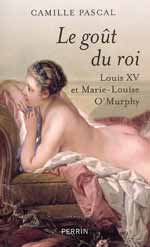 concealing? Take the 18th century painting, Fille allongée or Reclining Girl, by Francois Boucher. You wouldn't know by looking that the voluptuous model is an Irish girl, painted when she was only 14 years old. And that it was thanks to this work of art that the girl shortly after became the mistress of King Louis XV. concealing? Take the 18th century painting, Fille allongée or Reclining Girl, by Francois Boucher. You wouldn't know by looking that the voluptuous model is an Irish girl, painted when she was only 14 years old. And that it was thanks to this work of art that the girl shortly after became the mistress of King Louis XV.
Le goût du roi, a recently published book by historian Camille Pascal, uncovers the romance, feeding us the gossip along with carefully documented fact. He relates how court painter Boucher saved the girl's posterior for posterity, and in more ways than one. Chances are that Marie-Louise O'Murphy, born 13 December 1737 in Rouen, would other-wise have followed her mother and four older sisters into a career as a prostitute - or actress, which in the 18th century was only marginally better. Happily, Boucher hired her off the streets of Paris to model for him, the king's
trusted valet and procurer Lebel took notice, and after approximately 24,000 livres (or 1,000 golden louis) chang-ed hands, she was brought to the 43-year-old king's bed chambers a virgin.
Becoming the royal mistress wasn't as straightforward as it sounds. As Mr Pascal writes, accommodating the sex life of royalty was (and is) a financial and political battleground, on which courtiers and their families could make or break their influence and careers. In 1752, when Marie-Louise became the first of Louis' girls to be stabled at a house in the infamous Parc aux Cerfs next to Versailles, a number of parties were scheming to be rid of his majesty's recently-platonic friend and
titled mistress, the charming, accomplished Marquise de Pompadour. This lady, slowing dying from tuberculosis, was apparently only too glad to let Marie-Louise and other girls like her take the night shift.
What has this to do with the Wild Geese? The grandfather of Marie-Louise O'Murphy fought with the Jacobite forces defeated at the Battle of the Boyne in 1690. He fled to France and established himself in Rouen in 1699 as a shoemaker. His Irish wife gave birth to Daniel O'Murphy, Jr., who followed in his father's footsteps, so to speak, working both for the king and in the family shop, and eventually marrying a none-too-good Irish girl, Marguerite O'Hicky. At one point the O'Murphys lived in St. Germain-en-Laye, where James II had died in exile, and which subsequently became a gathering place for Jacobites.
The family ended up settling in Paris, in the Montorgueil quarter. The author informs us that Casanova was staying with a friend just across the street from the O'Murphys, between 1750 and 1752, and in his memoirs relates his encounters with the O'Murphy sisters, while boasting that he once spent a surprisingly chaste evening with Marie-Louise. Another anecdote has it that Madame de Pompadour persuaded Boucher to use Marie-Louise as the model for the Madonna in his "The Rest on the Flight into Egypt" - which Pompadour then presented as a gift to the queen.
Called Sirette (the feminine of Sir) by her royal lover, Louison by historians and la Morfi or Morfise by the court, Marie-Louise lasted for a good three years on her Irish charm before she was schemed out of the palace and married off at the ripe age of 18 to a minor nobleman. Those three years made her fortune, though, along with a daughter that his majesty recognised and provided for. Furthermore, the author reports that in later years, and certainly during the Revolution, Marie-Louise would boast of her Irish heritage, eventually reverting back to her maiden name, as "Citoyenne Morfi". One of her sons is said to have saved her neck from the guillotine, and incidentally may have been the revolutionary who walked Louis XVI to the scaffold and gave the order for the drums to drown out his last words. But that is a story for another picture.
TOP
EXILS : THE IMPORTANCE OF BEING IRISH
by Declan Mc Cavana
What do Oscar Wilde, James Joyce and Samuel Beckett all have in common? 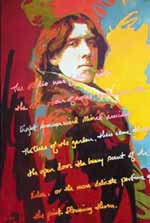 One: nationality. Two: occupation. Three: location. One: nationality. Two: occupation. Three: location.
All three of these great Irish writers dabbled with theatre and all three chose Paris as the place to lay down their pens.
All three wrote of universal values, opinions and emotions, and yet all three were profoundly, even unmistakeably, Hibernian in tone. All three fled their native shores and yet none of the three could escape the heritage that at times shackled them and yet simultaneously provided them with their dramatic artillery. All three exuded Irishness in their extreme essence and yet all three chose exile as the only exit. All three were travellers of the mind and on the page. All three flew their nests and became part of the Wild Geese.
The original Wild Geese, whose 400th anniversary we celebrate this year and with this special issue of The Irish Eyes, were forced to leave their home against their will, and certainly that demarcates them from Wilde, Joyce and Beckett. Nonetheless the latter followed directly in the tradition of their ancestors 300 years before them. Instead of turning to America, they felt their muse pull them elsewhere…to the "old" continent and not the "new" world. They felt that Paris with its freedom, both artistic and moral, could provide them with the necessary creative atmosphere to explore the country they had left behind, with the distance required for true objectivity.
Wilde had left Ireland for England where he had been persecuted for his sexuality, Joyce had left Ireland because she was "the old sow that eats her farrow" and Beckett not only left Ireland but also abandoned his native language to clothe himself and his work in new French robes. Nonetheless he, like the others, maintained an Irishness that was apparent in his turns of phrase, his narrative style, his characters' antics. As one critic says, "Sam left Ireland but Ireland didn't leave Sam".
Similarly, James Joyce, although he only rarely returned to Ireland after his original departure, concentrated his literary output on Irish subjects and notably the city he had decided to leave and yet which was to remain one of the greatest characters in all his work - Dublin. In Exiles, his only excursion into the drama field, he even goes as far as to write a play on the return of a self-exiled Irishman to his native city.
Wilde, Joyce and Beckett represented a new type of "exile"…they were not the Wild Geese of the past forced to flee their land, like Hugh O'Neill and Rory O'Donnell, for political or religious reasons. Rather they sought a different type of liberty: a freedom to express and describe, to experiment and to create. In addition, theirs was no passing whim, no youthful craving. They sought in Paris a permanent state of exile and yet belonging. Many other Irish dramatists, such as Boucicault, Synge or Yeats, came to Paris for inspiration and found it either in the theatres of this city or in the companions they made here (Synge in fact met Yeats for the first time in Paris). Yet they all returned to Ireland to apply their trade, to implement what they had learnt on the boulevards. Not so Wilde, Joyce and Beckett. The former and the latter both died in this city and are buried here (Wilde in Père Lachaise cemetery and Beckett in Montparnasse graveyard) and Joyce, although he passed away in Zurich, after having moved from Paris on account of the war, was still clearly most at home in the City of Light.
They each died far from their native land, as theatrical wild geese, but theirs was a conscious choice to abandon their country of birth and yet to pay homage to it from afar. None of them ever really returned physically to Ireland, perhaps for fear that, as Joyce put it, "a nation exacts a penance from those who dared to leave her - payable on their return" and yet each, in his own way, retained the quintessential nature of being Irish.www.cmgworldwide.comwww.jamesjoyce.ie
www.dublintourist.com
TOP
ARTS ON SEINE
by Ann Cremin
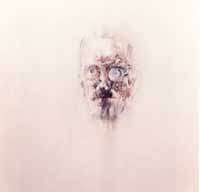 France, and Paris in particular, has always been a Mecca for visual artists from all over the world; even today when the market has been overtaken by New York and London, artists of every stripe still flock to the City of Light - as much for the aura attached to its name as for the possibilities of seeing work by many creative artists. Irish artists were not slow to follow the trend, and there are still traces to be found nowadays of their more or less brief sojourns here. France, and Paris in particular, has always been a Mecca for visual artists from all over the world; even today when the market has been overtaken by New York and London, artists of every stripe still flock to the City of Light - as much for the aura attached to its name as for the possibilities of seeing work by many creative artists. Irish artists were not slow to follow the trend, and there are still traces to be found nowadays of their more or less brief sojourns here.
Irish women have always held a special appeal and many of them made careers as models, where their unusual colouring and characters appealed to many artists. Among these is to be found Joanna Hiffernan, model and mistress of James Whistler, the American painter based in France. She is perhaps not recognisable but she was the model for Courbet's "L'Origine du monde" which had a lasting impact on the visual arts world. Courbet also painted her as "La Belle Irlandaise" where her luxuriant red hair and pearly skin are seen to full advantage.
Nearer our own time, the late Michael Farrell painted a series of nudes tumbling about, with the sibylline inscription: "Miss O'Murphy, after Boucher - the very first Irish political picture".
Roderick O'Connor, friend and disciple of Gauguin, was a world-renowned Irish painter who lived and worked in France and who spent most of his long life in Pont-Aven. He died in France, and some of his works still occasionally turn up in the townships of Brittany and surrounding areas.
In the 20th century, there were several leading Irish artists who lived, if not continuously then very frequently, in Paris and points south. For instance, Francis Bacon, towering over the post-war generations, spent his early childhood near Dublin, where his father trained horses and he passed many afternoons in the elegant, if faded, gentility of the hunting set. He once told me that the bow windows so often found in his interiors were those of his aunt's house in Kildare. He also added, somewhat cynically (and perhaps disingenuously): "The English hate me you know, because I'm Irish…" Be that as it may, the fact remains that his fabled studio, a work of art in its own right, was transferred to Dublin where it can be seen in the Municipal Gallery, Charlemont House, complete in every detail. Well worth visiting, by the way.
Another long-time resident in France, and happily still with us, is Louis Le Brocquy. He and his wife the painter Anne Madden spent many years in the south, not far from Nice, and close to the Maeght Foundation, where they were both exhibited. They still have very close links with the French art world and are regularly shown in Paris and elsewhere.
Recently the Irish College showed new works by Eithne Jordan, who spends part of the year in southwestern France, and currently in the College is to be seen Richard Gorman who also spent some time in Paris, working with the Atelier Champfleury. In the same workshop was also to be found the above-mentioned Michael Farrell, two of whose sons are visual artists, who have spent practically all their lives in Paris. Another Parisian is John Lalor, who has been exhibited in Nice and Corsica as well as at the College.
This list is by no means exhaustive but it serves to recall that France has been a land of refuge to every kind of creative Irish people, not just the literary "types".
TOP
E-mail: contact@irisheyes.fr
© Copyright Irish Eyes |